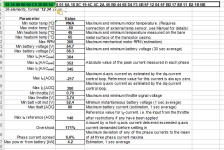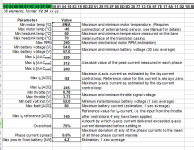incememed said:
It appears that ebikes.ca uses something close to 9.2 in their simulator for the HS3548.
Seems so strange to find so many values for one motor out there. I wonder how much of it is simple data entry mistakes, and how much of it someone having been sent the wrong motor vs what it's marked or what they ordered (like what happened to you), so they report back numbers for a different motor without knowing it. (could even be the case for my own motor) And how much people reporting data that they tested incorrectly.
Anyway, I did a short round the block of testing with the 84mohm and 13kV, leaving inductance at 200uH, and it ran about the same as it did with the 100mohm and 12.48kV. The "washboard" vibration was more pronounced, however, when pushing throttle higher, at any speed, not just low speeds. The controller and the motor both got pretty hot, checked by hand. Stats were going to be at the end of the post, but will be attached later; I have puppies nosing around and it's getting hard to type. Gonna have to go do playtime first.
THen I changed the inductance, up to 250uH, and was about to try again, when I remembered (because of the stats showing negative for minimum motor temperature) that I hadn't enabled the temperature sensor in the separate page for that on the settings sheet. So I "x"d the box for that, leaving the rest of the settings as they were (because I'm using the supplied thermistor, transferred over from the 4503 to the HS3548).
I then hooked up to resend the settings, but realized that the controller doesn't get this info, it already just reads whatever is attached. The temperature sensor stuff is just for the stats sheet, so it can interpret the numbers the controller itself sends back, for any particular sensor.
So I disconnected the serial cable, and switched the controller on at the Status LED panel, then tried an onground test without me on the trike, to see if it could push it forward on it's own, and it "stuttered" instead, but louder than usual (not as loud as the BANGs, but something a lot like the stutter I get when the generic trap sensorless controller gets "stuck" trying to startup the other wheel). I let go throttle immediately.
I saw a flashing code but wasn't looking directly at the LEDs, and by the time I was, it had gone blank. I then lifted the side of the trike off ground, to try a no-load wheel test, but got no throttle response. I switched it off and on at the status, but no startup-sequence on the LEDs. Power cycled at the battery cutoff, and same--no response. Rest of trike is operating normally, including leftside generic controller, and they're all powered from teh same BMSless battery, etc.
I felt the controller and motor and they were hot, not too hot to keep my hand on but much warmer than the 100F+ degree air. At a guess, possibly 120-130F. Don't presently have access to the IR thermometer.
I disconnected power again (at the batteyr cutoff), and tried to get stats, but there was no responce (or status LED).
So I'm letting it all sit unpowered for a long while during dinner/etc, and see if it "recovers", in case it was overheated and at shutdown temperature. I may have a nap first, too.
Current is always and only modulated by the throttle, no middlemen. The user is in control of the current at all times, except for when limited for thermal reasons.
The startup algorithm is work-in-progress to get cleaner un-assisted startups from standstill at low to moderate load. While it works well with my geared RC-setup, I have not heard any other user having any help from it, yet. In its present form I doubt your setup has much to gain from experimenting with this function.
Ah; ok. I misunderstood it's mechanism. I'll still try it once I get that far; whatever results I get may help you anyway.
As for now, I refrain from implementing any automated/forced/sequential startup routines, since that would perhaps work well under some circumstances but likely get in the way under others, such as when stuck in mud, rocks, steep inclines, etc on the trail. And it would be vehicle dependent, so less universality.
True. Unless there's some way to select "which routine" a particular system uses, and just include a few potentially useful ones, but that would probably make things unnecessarily complex. :/
The main goal when developing the SFOC was to make it thermally indestructible. It is supposed to limit itself to what the hardware can sustain. So by all means, give it hell. I see this prototyping as an anti-fragile process, if a design or manufacturing flaw can be tied to a failure, it can be improved on. I will try to get you a replacement if that would happen.
I'm not actually worried about blowing the controller (although that may have actually happened earlier tonight; we'll know later), I'm worried about breaking more axles.

I have a few controllers I can use, though they are just generic 12FETs of various types, 20-40A battery current limits. Motors are another thing....
(depending on how it breaks, I might have to do some creative roadside repair just to keep the wheel on there to let me get home--been lucky to not have to do that so far)
That BANG! problem happened at higher currents, and I'm not eager to experience one on the HS3548's axle, at least not until I have "bulletproofed" the 4503's axle and gotten it ready to go back on the trike.
I do still have an old X5304 (smaller cousing to the X540x series), taht I've repaired an axle on, but it's an untested repair, and it's not laced in a rim, so to even test it I'd have to take the spokes and rim off something else and lace it up. Past that, I'm out of motors that are capable of enough torque to be useful on the trike. (I still have a rear "2807" type, but it's unlaced, and not a high torque motor by any means...everything else is a front motor IIRC, and would require rebuilding the trike's rear wheel mounts to use. (the X5304 is actually a front motor, but the axle repair allowed me to lengthen the inboard side to let it work in place of a rear, hopefully).
If I had a better way to replace axles with bigger better designs, and make new covers with big bearings, I'd just do that, and not worry about breaking stuff, but I don't have that ability yet, and I have to use the trike for everyday stuff.
I've had others report the same, motor "comes alive" as rpm increases. Rotor position estimation plays a role here, and I'm working on that. Once the cut-outs and the hiss and the high temp are resolved, we can get to some more explorative testing.
That sounds like a plan.

Cuz one thing people generally expect from a high power controller is being able to access that power at any speed, and get potentially wheelie-popping tire-smoking torque

if their vehcile/weight/motor etc would otherwise allow that to happen.
(I suspect that if I could get full current at zero speed from the SFOC5, and I had one on each of htose MXUS 450x''s, I could probably at least lift the front end off the ground a little bit. Maybe not with me on it...but that's ok; I'm not after wheelies or smoking tires. I just want the fastest possible accelration given the torque potential available, from zero speed up to 20MPH, and mostly down at the bottom end of that speed range.
Having the really good accleration even at 20MPH (much better than the generics) is potentially useful in traffic situations, where a car or truck / etc suddenly decides to be where I am, and traffic behind me would run me over if I braked to avoid colllision, but there's almost always clear space in front of me because I'm slower than most other traffic on roads where this is potentially going to happen.
But beign able to get out of the way of traffic behind me at a red light turning green is also important, as well as several places I frequently have to make turns at where I cross a road indirectly--turning right at an intersection, crossing two to four lanes in a few dozen yards, and making a left turn from the isolated median-turn-lane. These are places wehre it's not possible to go straight thru the intersection, either illegal or physically impossible due to intersection construction.
The catch is that while I can turn right even during a red light for my direction, I can only do it when there's a big enough traffic gap to ensure I can accelerate into it *and* reach the safety of the median lane. The quicker I can accelerate, the more likely I can do this safely, especially if I have "reserve acceleration" at max speed in case some driver sees me and accelerates to try to prevent me from crossing (it happens to cars too); and if I"m already committed I *have* to get over and out of the way, or risk being hit from behind by a car that simply doesn't care or doesn't realize how much slower I am than they are, etc.
Right now I may have to wait for up to a couple of minutes (the whole light cycle time at the slowest-changing one), and since cars are waiting behind me that *could* have turned if I weren't in their way, they sometimes get impatient, and every so often someone will be angry and either yell at me to move (which I can't) or do something unsafe and just go around me in the next lane to the left, or between me and the next lane, while traffic is still zooming past in front of us. This kind of thing is still going to happen regardless of capabilities...but the more I can prevent it, the safer everyone (especially me) is.

The other separate issue is hauling cargo especially really heavy stuff in the trailer, because taht can more than doulbe the mass the motors ahve to move, and the faster I can accelerate from a stop with all that, the better, too. (which equates to being able to haul it up slopes, which are not very long here in PHoenix for the most part--I don't need to go where there's hills or mountains, very much).
It's also more fun to be able to accelerate really really quickly. :lol:
That being said, upping the phase amp limit does make things happen.
In comparison, the generic controller translates throttle position to semiconductor duty cycle. At low speeds, there is not much bemf to stop the resulting flow of current, and with high power setups off you go whether you like it or not.
Not too worried about that with mine, given the inertia it has to overcome.

I'm sure it will get better both as the software evolves, and as I get settings nailed down to be able to increase the current limits.



